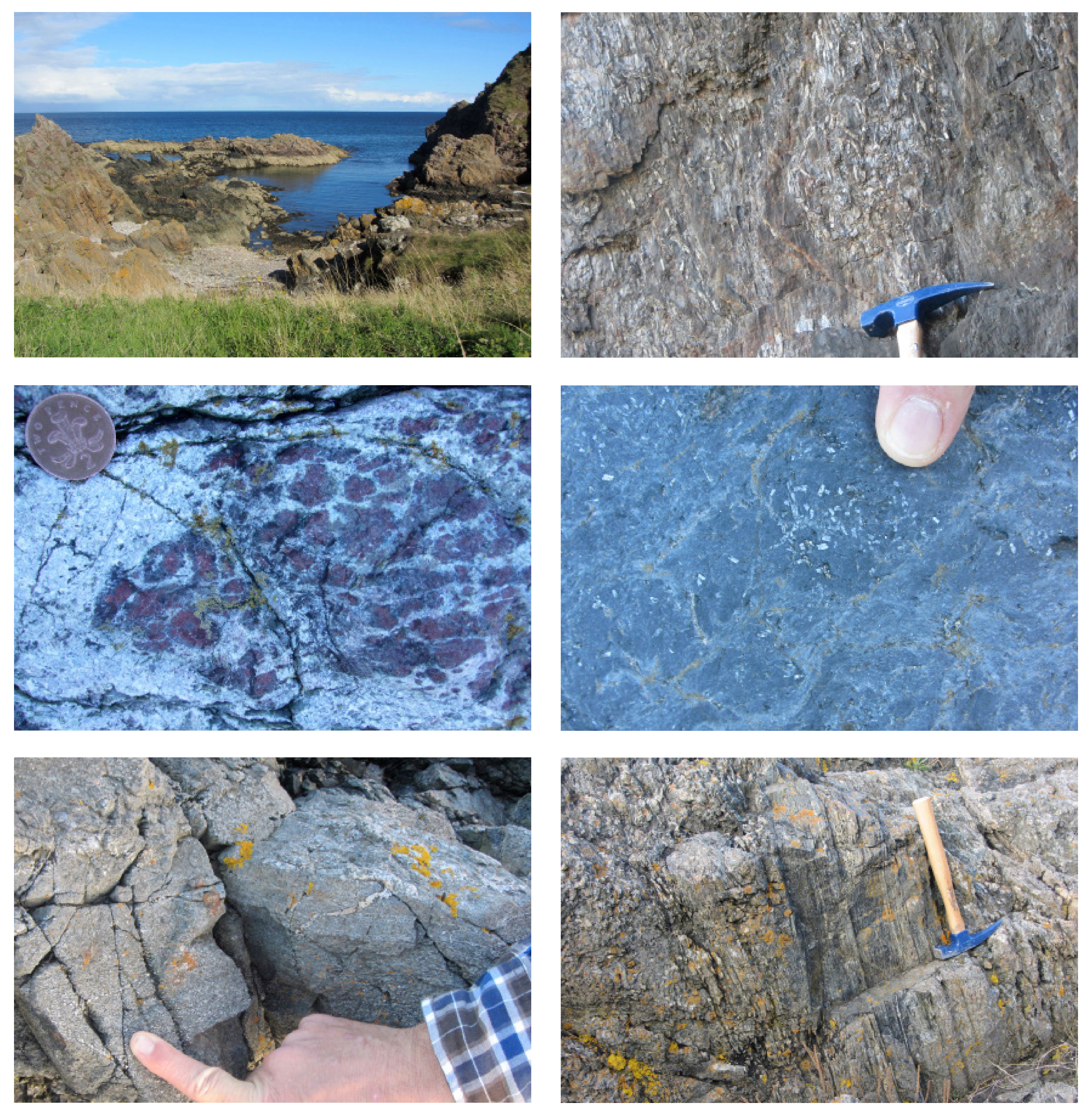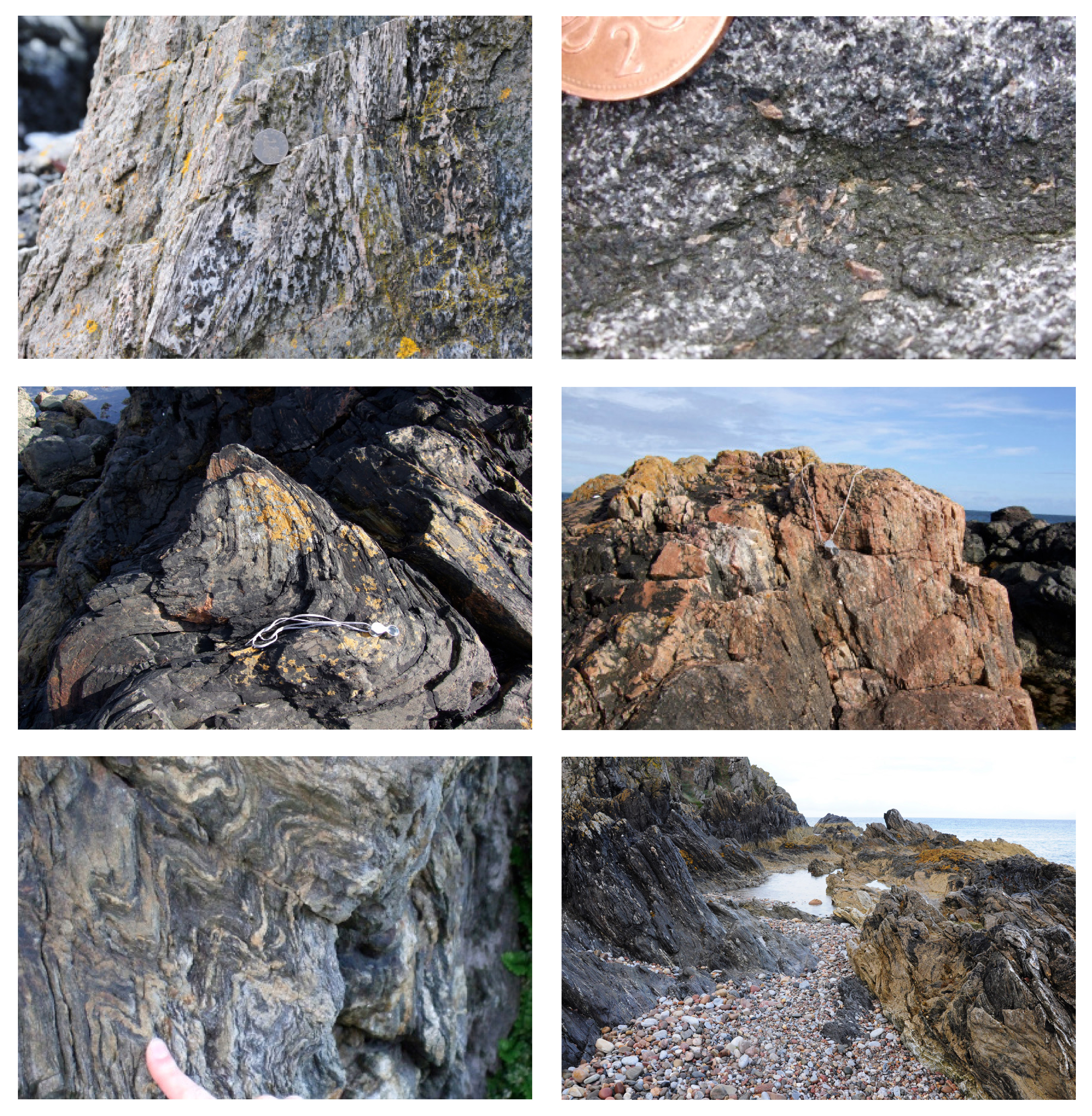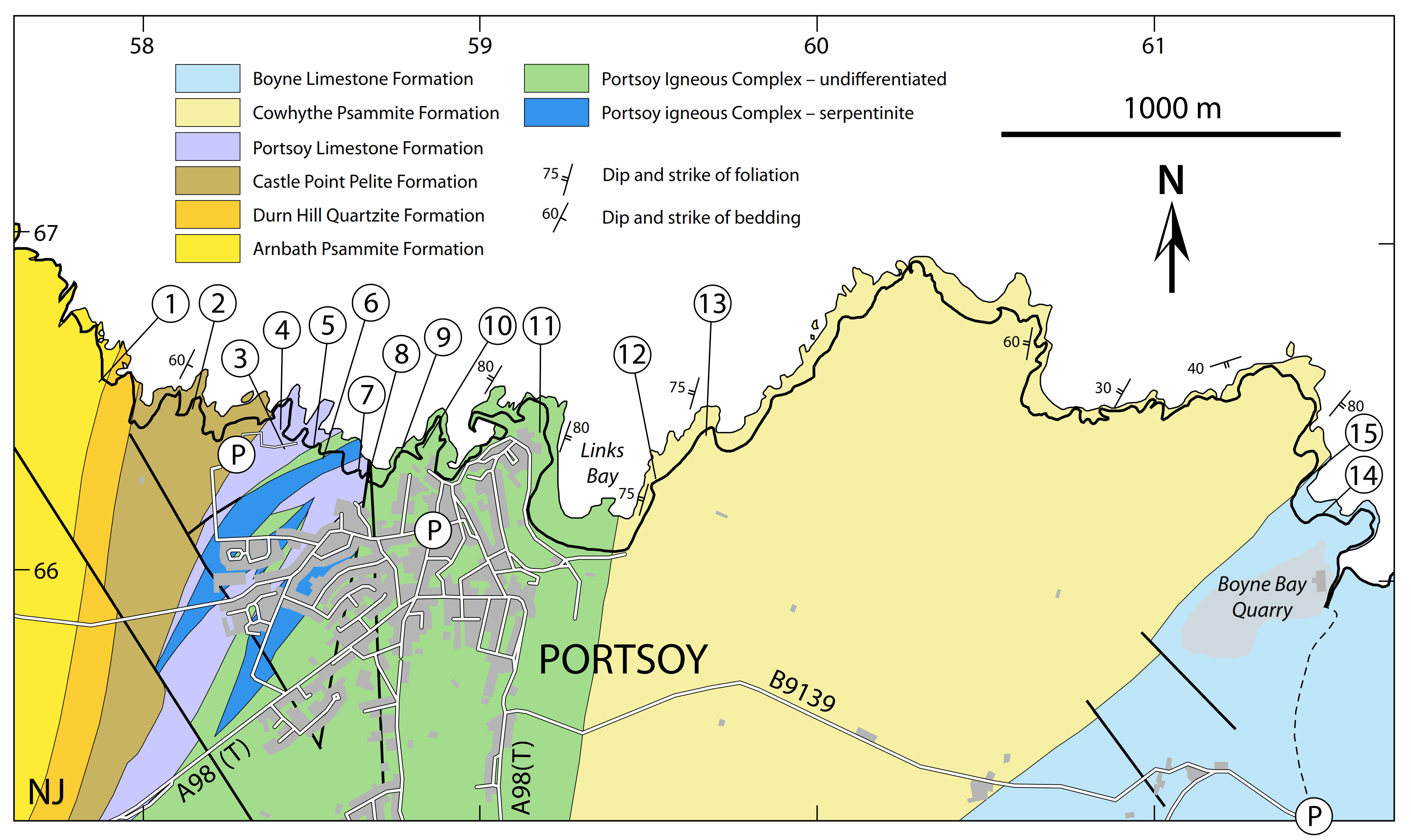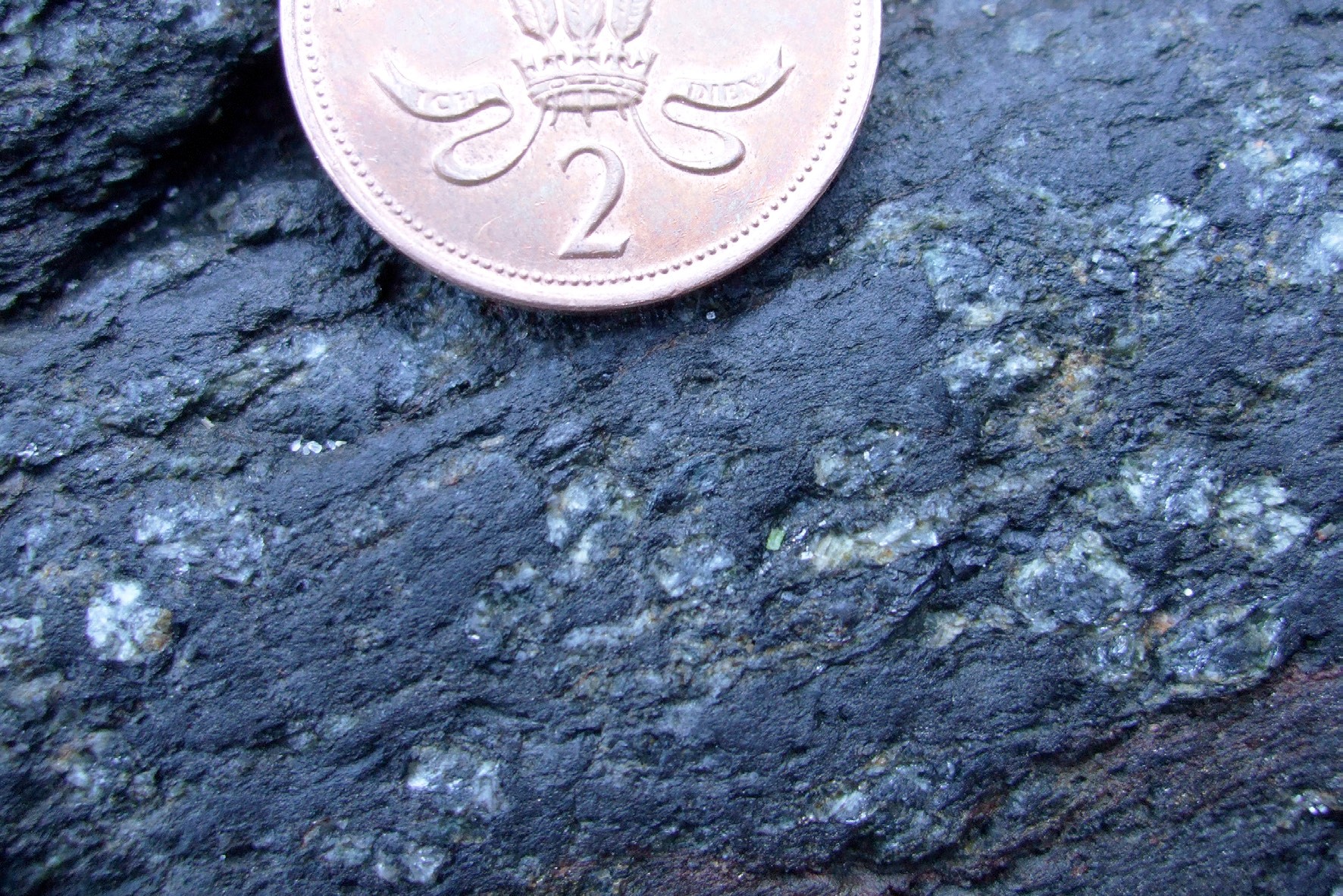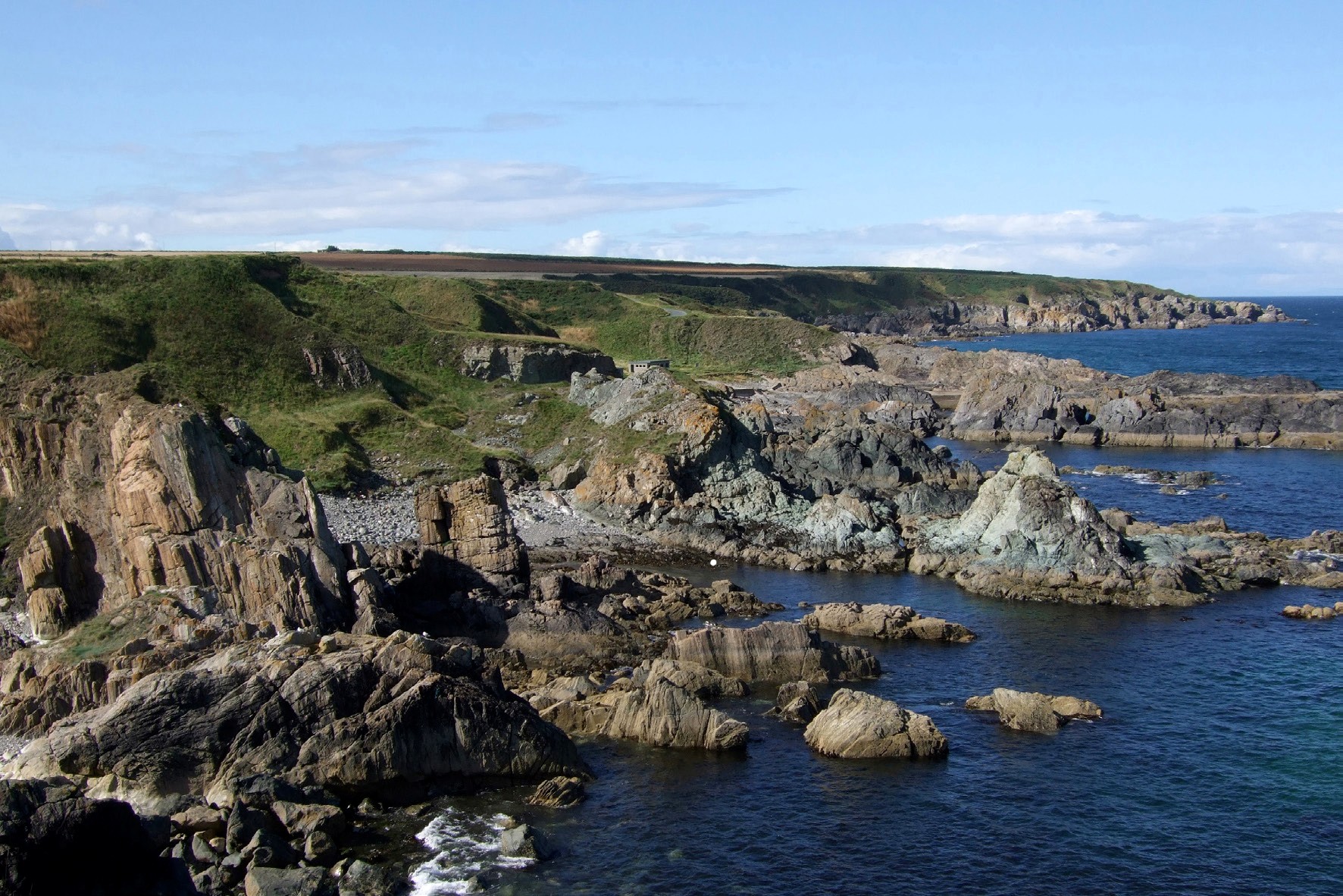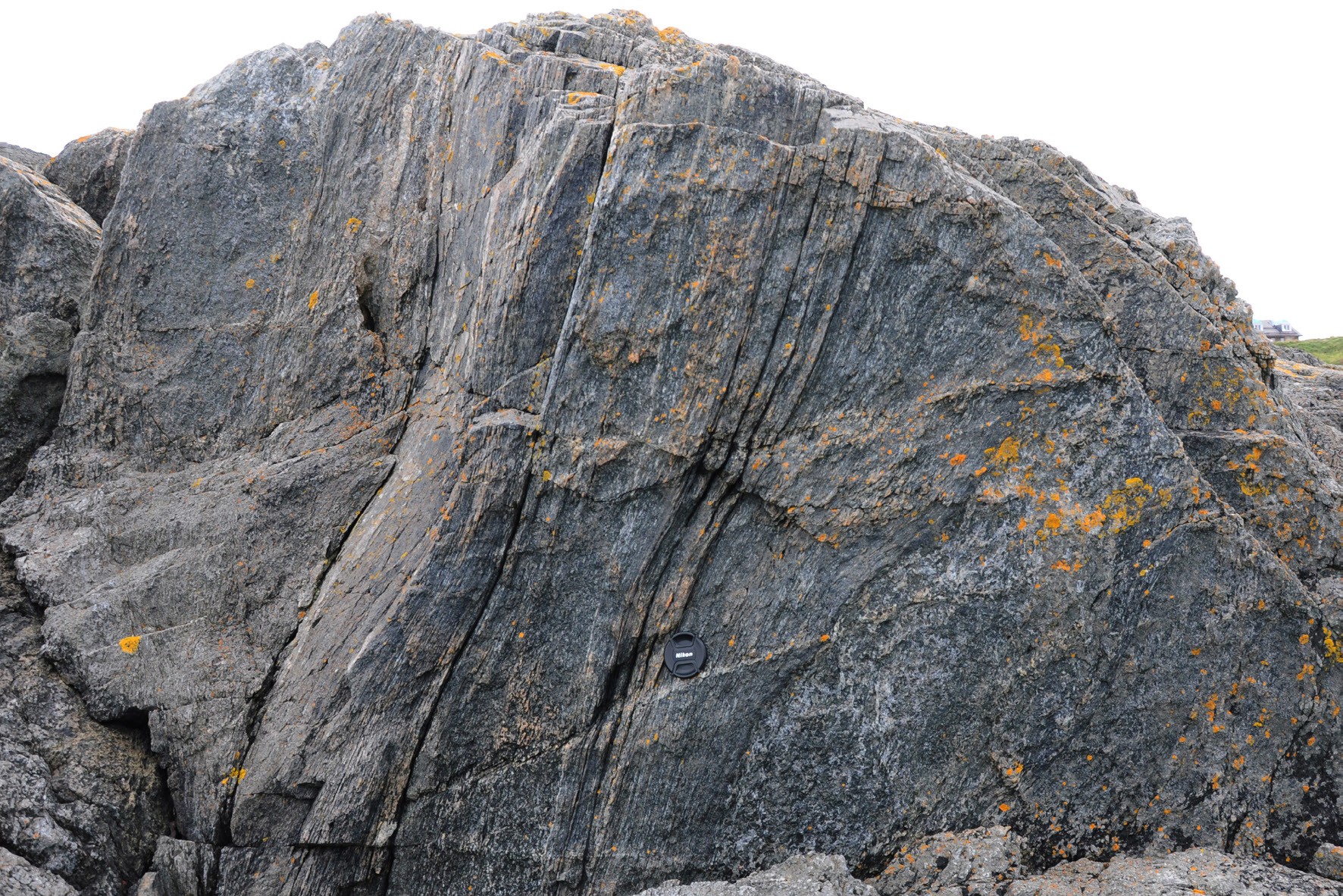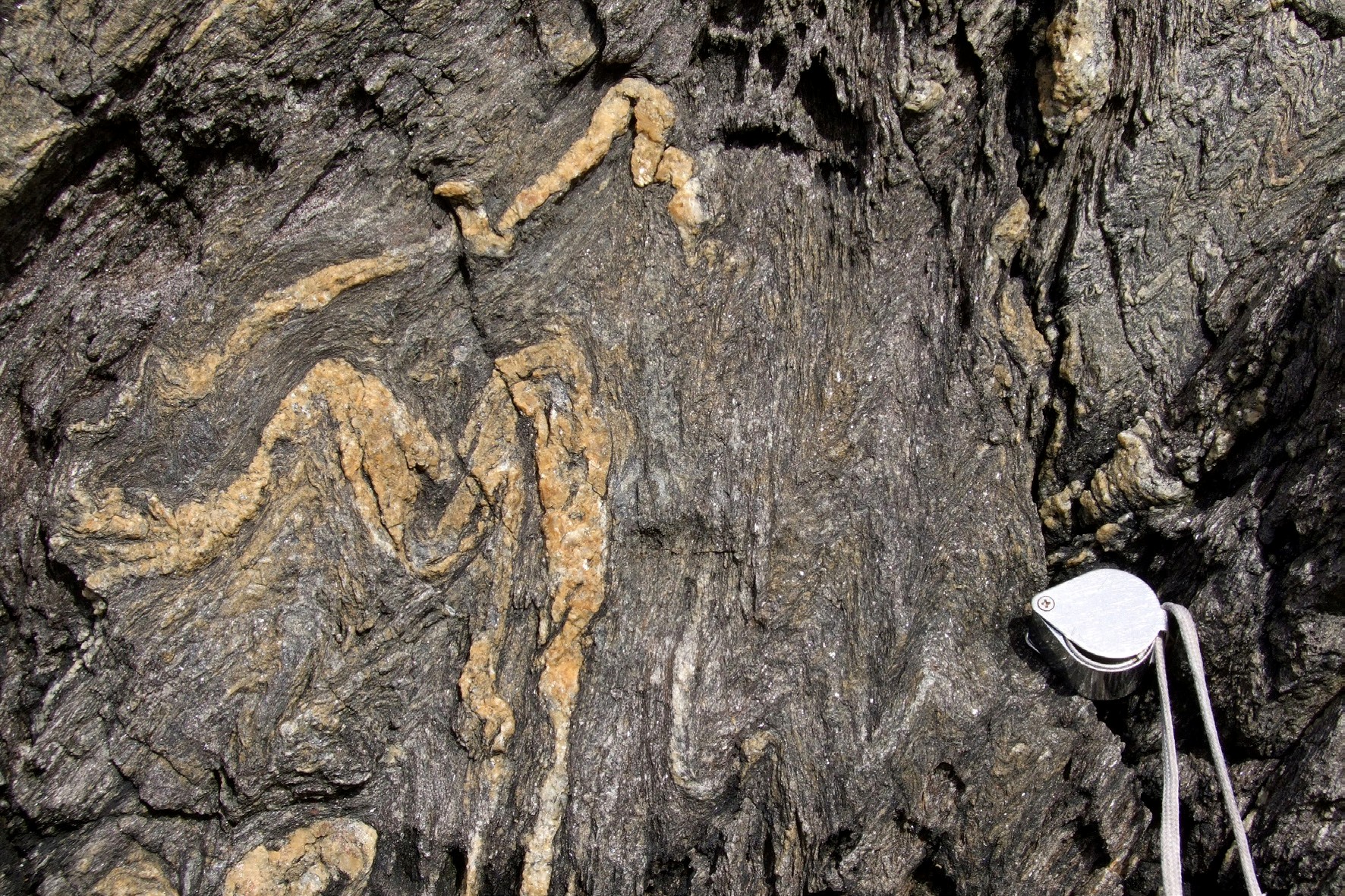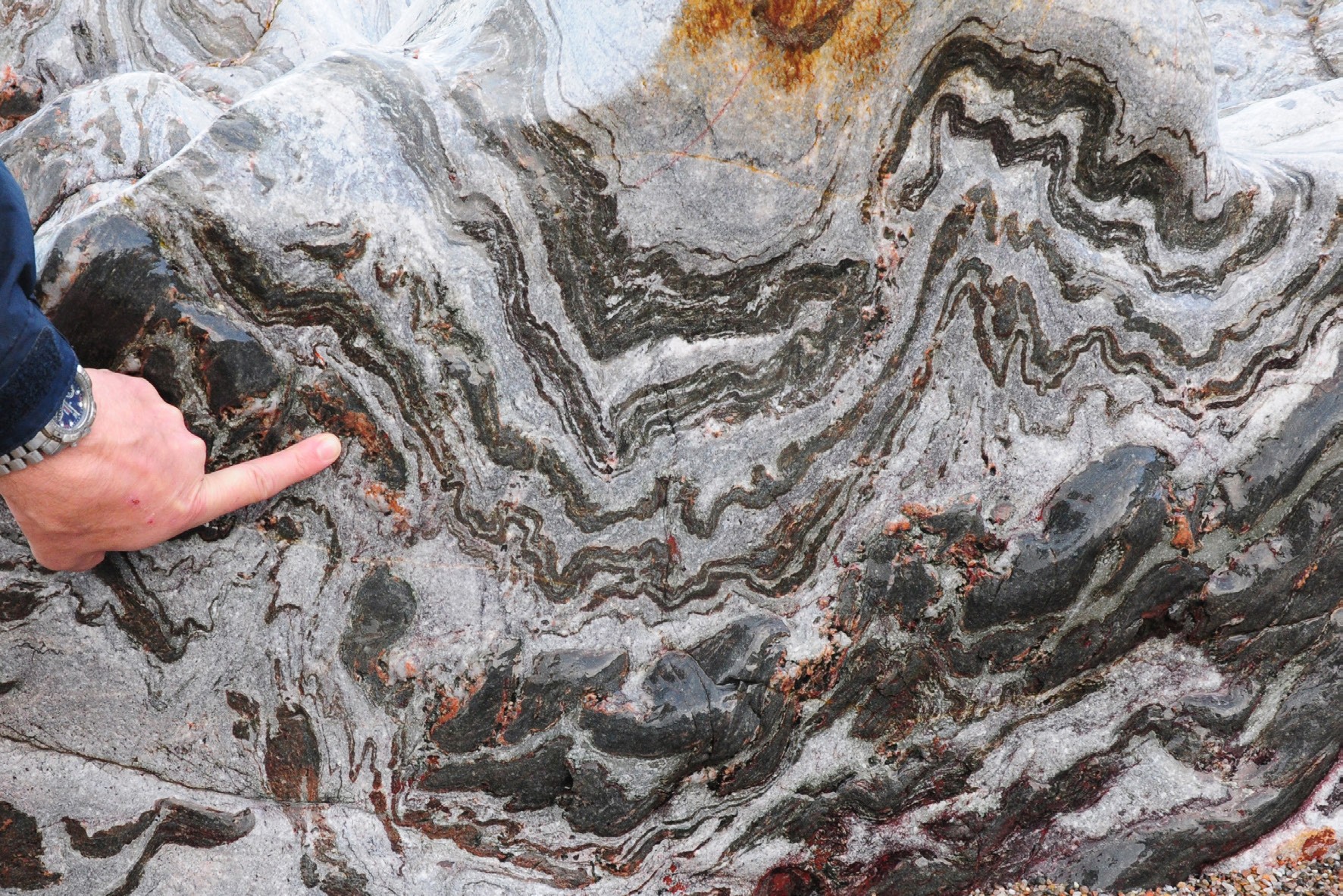Show interactive timeline
3 The Dalradian of the Portsoy area
J. P. Carty and T. E. Johnson
Purpose
To examine amphibolite facies
Access
Portsoy is a picturesque village with a 17th century harbour situated on the Banffshire coast some 70 km NNW of Aberdeen and 95 km east of Inverness. When entering Portsoy on the main road (A98), turn north into South High Street and park in The Square
Introduction
A wide range of deformed and metamorphosed
At the base (western end) of the section the Arnbath Psammite comprises metamorphosed psammites and migmatitic semipelites and contains a boulder bed correlated with the Port Askaig Tillite (Spencer and Pitcher, 1968). It is overlain by quartzites and metapsammites of the
East of Portsoy lies the
1981). The
Itinerary
Locality 1. Arnbath Psammite Formation & 'Older' intrusive rocks [NJ 5787 6659]
If on foot, walk up Cullen Street then turn second right into Marine Terrace and join the cliff-top path that leads westwards to a car park on the cliff top above the open-air swimming pool (
Looking seaward, from left to right (west to east) the rocks comprise: The
Locality 2. Garnet–staurolite schist [NJ 5814 6650]
Climb back up the slope to the cliff top and head back most of the way towards the car park and to the eastern side of a grassy promontory (around 400 m from locality 1). Descend the grassy slope to the western side of the rocky headland (Castle Point) to exposures on the steep hillside. The rocks here are muscovite-rich metapelites belonging to the
Locality 3. Chiastolite schist [NJ 5842 6638]
Return to the cliff top and back to the road, passing the car park and descending the steep winding road to the swimming pool (you can drive a car down if you prefer). The first prominent crag immediately on the south side of the road is of dark metapelite containing abundant pale prismatic 'porphyroblasts' up to 4 cm in length. This rock also crops out in low wave-washed exposures along strike (NE) close to the high water mark
Close examination shows that the majority of the 'porphyroblasts' are aggregates dominated by muscovite (i.e. they are pseudomorphs), although some have cores preserving fresh andalusite. The porphyroblasts/pseudomorphs are oriented within, and wrapped by, the strong S2 foliation. Most are aligned parallel to a steeply plunging L2 lineation although others are at a high angle to L2. On subhorizontal surfaces (e.g. the wave washed exposures close to the high water mark) relict chiastolite crosses are clearly preserved
The timing and sequence of Al2SiO5 growth in this rock is contentious. Some workers (Beddoe- Stephens, 1990; Carty, 2001; Carty et al., 2012) consider the sequence to be andalusite to sillimanite to kyanite, whereas others interpret the sequence as andalusite to kyanite to sillimanite (Viete et al., 2010). The order of growth of these minerals has important implications for the pressure–temperature– deformation–time path followed by the rocks and consequently for models attempting to explain the tectonothermal evolution of the NE Dalradian.
Locality 4. The 'Portsoy Limestone' [NJ 5841 6644]
The rocks exposed within the swimming pool and on the headland to the north consist of an alternating sequence of metalimestones and siliceous material ('Portsoy Limestone'). Excellent examples of F2 folds are developed. The folds are tight to isoclinal and vary in intensity, sometimes occurring as isolated fold hinges. F2 fold axes plunge steeply down dip, sub-parallel to a mineral stretching lineation. The S2 foliation is axial planar to these folds. In the crags beyond the western wall of the swimming pool, later F3 folds can be seen to deform the S2 foliation.
Locality 5. Greenschist facies shear zones [NJ 5851 6638]
Join the poorly defined path eastwards along the shoreline. A few metres north of the path, close to the high water mark, large blocks and lenses of weakly deformed metagabbro are wrapped by an intense anastomosing shear fabric developed within fine-grained metagabbro. The large blocks preserve amphibolite facies assemblages dominated by hornblende and plagioclase whereas the intensely deformed material is rich in chlorite and quartz and records lower-grade (greenschist facies) conditions. As most of the shear zones in the section preserve amphibolite facies assemblages (see localities 8 & 9), these features suggest later shearing during retrogression (Carty, 2001).
Locality 6. Portsoy 'marble' [NJ 5854 6636]
Continue on the path a few tens of metres to the western edge of the prominent pale green-grey exposures of Portsoy 'marble'. The rock is actually serpentinite (a metamorphosed and hydrated ultramafic rock), varying in colour from nearly black through dark green to light green and containing thin bands and veins of red jasper and white quartz (Gillen, 1987). Exposures close to the high water mark contain dark red aggregates of iddingsite pseudomorphing primary olivine. Steeply-inclined veins within the main body of the serpentinite contain abundant talc. Exposures close to the low water mark show that the sepentinite is in places highly folded.
If the tide is high, proceed eastwards by climbing up the steep grassy slope to the path, then down to the shore again after about 50 m. At the eastern margin of the body
Locality 7. 'Mullioned' quartzite [NJ 5865 6632]
Walk across the bay a short distance to impressive exposures of quartzite, which is buff-coloured when weathered but white on fresh faces. The quartzite contains a steep lineation and forms distinctive rods or 'mullions'
Locality 8. Anorthosite [NJ 5867 6628]
Jutting out from the base of the grassy slope in the bay to the east of the prominent exposures of quartzite is an exposure of pale-grey to cream coarse-grained metamorphosed anorthosite. It is composed primarily of plagioclase (labradorite) with accessory amphibole and chlorite and is cut by minor shear zones. Its contact relations are unexposed but are presumably tectonic.
Ascend the steep grassy slope to the cliff-top path. If driving, walk westwards back to the car park and return the way you came, parking in The Square or at the old harbour near the Portsoy Marble Shop. If on foot, walk eastwards and follow the path north round the steep grassy slope, from which there are excellent views of the 'mullioned' quartzite and serpentinite body
Locality 9. Sheared metagabbro at the old hospital tip [NJ 5877 6637]
On either side of the broken railings are exposures of what appear to be two generations of metagabbro. Fine-grained metagabbro is in places cross-cut by coarse-grained to pegmatitic metagabbro, although both types are deformed within anastomosing D2 shear zones suggesting syn- kinematic (syn-D2) intrusion. The ductile shear deformation is strongly heterogeneous. Individual shear zones range from a few millimetres to several metres across, within which there is an intense grain-size reduction
Locality 10. Sheared metagabbro and calc-silicate zenoliths [NJ 5884 6639]
Follow the small path round the back of the Marble Shop to the gable end of a derelict building.
Metagabbros immediately below the southwest of the building preserve excellent examples of the D2 shear zones that extend along strike from locality 9. Top to the NW shear sense indicators are particularly well developed in discrete shear zones that dip 40–60° towards the SE.
Walk NNE onto the rocky peninsula of Doonie Point. Xenoliths of metasediment within a generally weakly-deformed fine-grained metagabbro are mostly diopside-rich calc-silicate. Patches and veins of almost pure hornblende are common in the metagabbros in close proximity to the calc-silicate xenoliths (e.g. on the elevated exposure at
Locality 11. Xenoliths in metagabbro and refolded folds [NJ 5920 6643]
Walk around the old harbour and up Shore Street onto the headland east of the new harbour.
The metagabbros contain numerous metasedimentary xenoliths, mainly calc-silicate and marble, and are cut by a number of granitic pegmatite sheets. Some elongate xenoliths are intensely deformed and there are nice examples of refolded folds (F3 refolding F2) in both the xenoliths and metagabbro. The pegmatites, which are up to a few metres in thickness, range from undeformed to highly deformed, suggesting they intruded syn- to post-D2. An undeformed pegmatite that cross-cuts the S2 fabric has been dated by Carty et al. (2012) at 474 +5/−
Locality 12. Cowhythe Psammite Formation migmatites [NJ 5954 6629]
Walk around Links Bay to its eastern side, where the folded contact between calc-silicate and metasemipelitic rocks of the
The
Locality 13. Tourmaline pegmatites [NJ 5969 6642]
Some 150 m further north, at the western entrance to a small bay, several pegmatites intrude the migmatites. These are generally aligned subparallel to the foliation but are weakly deformed or undeformed. Large euhedral grains of tourmaline are abundant. Chilled margins are absent and some contacts are diffuse suggesting the pegmatites were emplaced close to the metamorphic peak.
If time permits, continue along the path to
Return to the car and the A98 and drive east. Around 250 m after the sharp bend south, just as you are leaving Portsoy, take the left turn onto the B9139 (not signposted). Continue on this narrow road, crossing the Burn of Boyne, and turn left at the junction. Continue for around 200 m then turn left (north) and park near the end of the track that leads to Boyne Bay Quarry
Locality 14. Boyne Limestone Formation [NJ 6153 6618]
In the southern part of the bay are exposed an interbedded sequence of marbles and metapelites that exhibit spectacular F3 folds, many of which are apparently refolded F1 folds. Sheath folds are particularly common. Metapelitic layers contains fibrolite and small, coarse-grained quartzofeldspathic segregations
Locality 15. Boyne Limestone Formation –Cowhythe Psammite Formation contact [NJ 6146 6627]
On the northern side of the bay the faulted contact between the
If time and tide permit, continue round the headland to Cowhythe Head to extensive exposures of the
References
Ashcroft, W.A., Kneller, B.C., Leslie, A.G. & Munro, M. (1984). Major shear zones and autochthonous Dalradian in the north-east Scottish Caledonides. Nature 310, 760–762.
Ashworth, J.R. (1975). The sillimanite zones of the Huntly-Portsoy area in the north–east Dalradian, Scotland. Geological Magazine 112, 113–224.
Beddoe-Stephens, B. (1990). Pressures and temperatures of Dalradian metamorphism and the andalusite–kyanite transformation in the northeast Grampians. Scottish Journal of Geology 26, 3–14.
Carty, J.P., Connelly, J.N., Hudson, N.F.C. & Gale, J.F.W. (2012). Constraints on the timing of deformation, magmatism and metamorphism in the Dalradian of NE Scotland. Scottish Journal of Geology 48, 103–117.
Carty, J.P. (2001). Deformation magmatism and metamorphism in the Portsoy Shear Zone, north-east Scotland. Unpublished PhD Thesis, University of Derby.
Dempster, T.J., Hudson, N.F.C. & Rogers, G. (1995). Metamorphism and cooling of the NE Dalradian. Journal of the Geological Society, London 152, 383–390.
Elles, G.L. (1931). Notes on the Portsoy coastal district. Geological Magazine 68, 24–34.
Fettes, D.J., Graham, C.M., Harte, B. & Plant, J.A. (1986). Lineaments and basement domains: An alternative view of Dalradian evolution. Journal of the Geological Society, London 143, 453–464.
Gillen, C. (1987). Dalradian of the Portsoy district. In: Trewin, N.H., Kneller, B.C. & Gillen, C. (eds) Geology of the Aberdeen area. Scottish Academic Press, Edinburgh, 71–78.
Harris, A.L. & Pitcher, W.S. (1975). The Dalradian Supergoup. In: Harris, A.L., Shackleton, R.M., Watson, J.V., Downie, C., Harland, W.B., Moorbath, S. (Eds). A Correlation of
Moig, N.A.W. (1986). A structural study of the Dalradian rocks of the Banff coastal transect, NE Scotland. Unpublished PhD Thesis, University of Dundee.
Read, H.H. (1923). The geology of the country round Banff, Huntly and Turriff. Memoirs of the Geological Survey of Great Britain.
Read, H.H. (1960). North-east Scotland: the Dalradian. Geologists' Association Guide No. 31. Colchester, Benham & Co. Stephenson, D., Mendhum, J.R., Fettes, D.J. & Leslie, A.G. (2013). The Dalradian rocks of Scotland: an introduction. Proceedings of the Geologists' Association 124, 3–82.
Sutton, J. & Watson, J. (1955). The deposition of the Upper Dalradian rocks of the Banffshire coast. Proceedings of the Geologists' Association 66, 101–133.
Treagus, J.E. & Roberts, J.L. (1981). The Boyndie Syncline, a D1 structure in the Dalradian of Scotland. Geological Journal 16, 125–135.
Viete, D.R., Richards, S.W., Lister, G.S., Oliver, G.H. & Banks, G.J. (2010). Lithospheric-scale extension during Grampian orogenesis in Scotland. Journal of the Geological Society of London Special Publications 335, 121–160.
Acknowledgements
Thanks to Richard White for funding fieldwork and to Giles Droop, Con Gillen and Dave Pattison for comments.
06/12/2013

